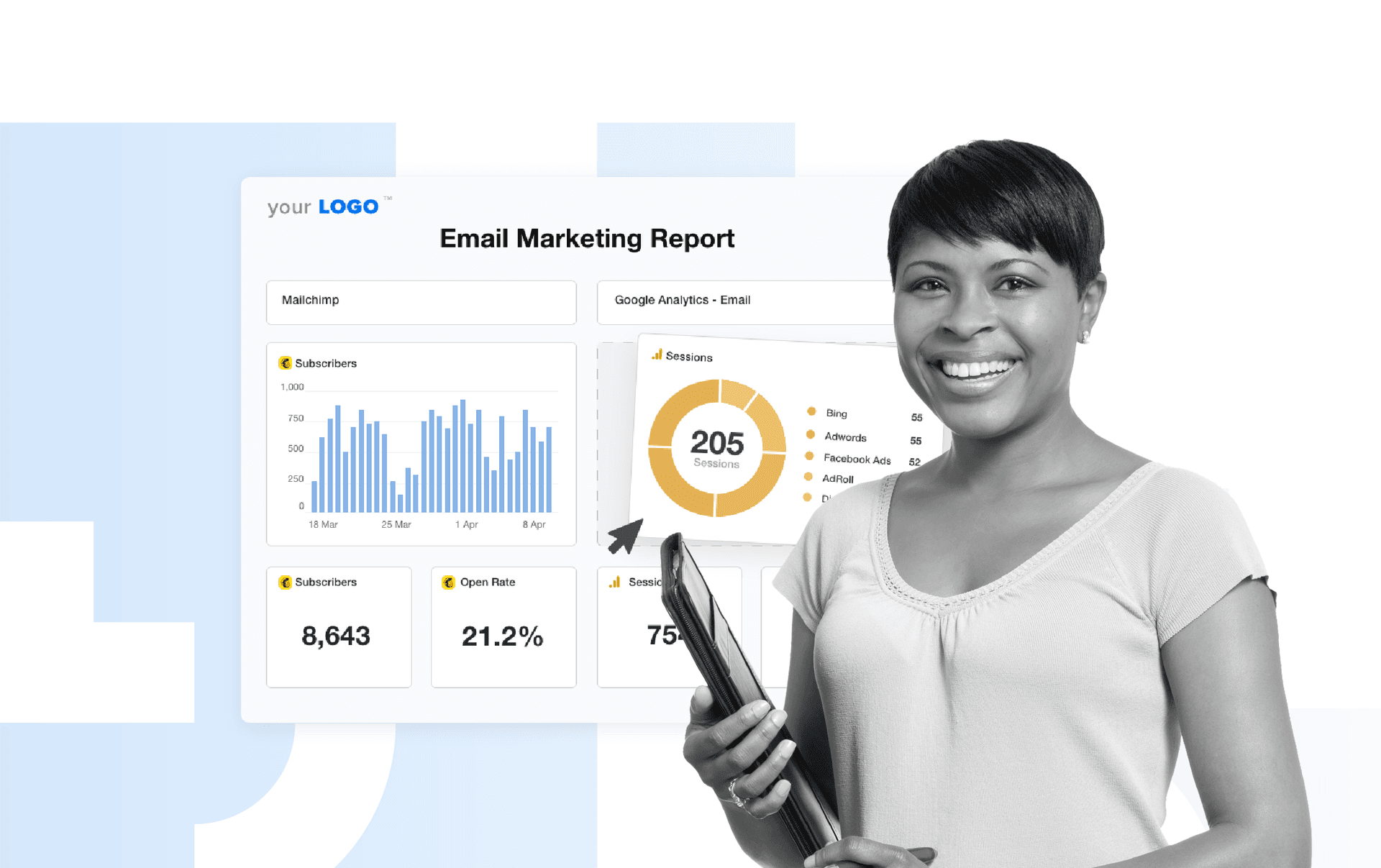Table of Contents
QUICK SUMMARY:
As an agency, it’s important to understand email marketing pricing and charge fairly. That said, it isn’t always straightforward or easy to determine. From navigating a client’s email marketing budget to covering the cost of email marketing tools, there are many moving parts to consider. This article covers best practices for determining an email marketing agency’s cost, various pricing strategies, and the importance of a robust reporting system.
When you think about an email marketing campaign, it's easy to underestimate the complexity involved.
From developing a solid email strategy and segmenting the audience to designing eye-catching templates, there's a lot to consider. And that's not even counting the ongoing efforts like crafting compelling copy and tracking performance metrics.
With all these moving parts involved, it’s natural to wonder, “How much does email marketing cost?” After all, time is money (quite literally for your agency, too).
If we’re being honest, deciding on appropriate pricing is one of the trickier parts of running an agency. From covering the cost of email marketing expenses to maintaining a competitive advantage, it’s not always a clear or an easy decision to make.
Whether your agency is just freshly launching an email marketing service vertical, or you’re a seasoned veteran wondering if your strategy is competitive, this article has you covered. We’ll explore what influences an agency’s email marketing costs, appropriate pricing models, and relevant examples.
What Factors Influence Email Marketing Pricing?
There are many variables that contribute to your agency’s email marketing cost–let’s explore them in more detail.
List Size
Managing larger lists often involves more complex segmentation and an increased sending frequency.
Consider a retail client with a mailing list of 100 subscribers. They don’t have an extensive product offering, which means a twice-a-month newsletter is sufficient. Plus, their email list has just two segments (new and repeat customers). Preparing content is pretty straightforward–it just takes a few hours per month.
That said, it’s a whole different ballpark for a client with 10,000 email subscribers. Their segmented lists are much more complex based on purchase history, location, engagement level, and subscriber preferences. From your end, it means creating multiple newsletters, revising strategies, and regularly cleaning email lists.
Given this increased scope of work, it means more time, resources, and–you guessed it–higher pricing.
Email list size impacts pricing, considering that it’s based on segmentation, volume, and the creation of different messaging. At our agency, we charge based on an estimated number of emails to be sent per month. If a client’s list is large and requires segmentation, our pricing will increase.
Ashley Procter, Partner, Pilot
Choice of Email Service Provider
Your chosen email marketing platform also influences pricing.
That’s because each provider comes with its own pricing structure and tiers. More specifically, this may include variations in:
Basic vs. Premium Options: Most email service providers offer a basic plan, which is usually suitable for small businesses or individuals. Moving to a higher-priced tier may include access to more features, high subscriber limits, and more sophisticated targeting.
Number of Subscribers: Pricing typically scales with the number of subscribers because it involves increased server load and data handling.
Email Sending Limits: Many platforms cap the number of emails sent per month at a specific price point. Users may have the option to increase this limit at an incremental cost or move to a more expensive tier with higher bandwidth.
Email Design
The complexity of email design should be factored into your agency’s pricing structure.
For example, consider how much time and resources are required to create a polished, on-brand newsletter. Simpler designs may simply require using in-platform pre-built email templates (like the example below).

In these scenarios, adding your client’s branding, email copy, and a couple of readymade graphics may do the trick. On the other hand, multi-layered, custom, or interactive email campaigns are more expensive (e.g., a large-scale seasonal launch for a fashion client). That’s because it may require:
Additional resources (e.g., the involvement of your Graphic Designer and a dedicated Email Marketing Coordinator).
Time-intensive A/B testing to determine the most effective email design (especially if your client has an engagement or conversion goal).
Proficiency in coding or experience with interactive elements (e.g., animations, embedded videos). This may require hiring a freelancer, a short-term resource, or a full-time Developer (if your agency needs this skill set on a long-term basis).
Simple text-based emails or minimal design work can be priced lower. Advanced content (emails with custom graphics, professional copywriting, and personalized elements) should command higher prices.
Shay Cohen, CEO, SFB Digital Marketing
Sending Frequency
Another contributing factor is the frequency of sending email campaigns. Naturally, creating or managing a higher volume of emails means more billable time expended. The result? Higher pricing.
Low email frequency (e.g., monthly) may have lower pricing since less frequent sends require fewer resources and ongoing management. High email frequency (e.g., weekly or daily) has a justified higher pricing due to the increased workload in managing, scheduling, and analyzing more campaigns.
Shay Cohen, CEO, SFB Digital Marketing
More specifically, consider the following:
Internal Staffing Needs: Frequent email campaigns may require a dedicated team of designers, writers, and marketers to produce and manage content. It may also require more brainstorming sessions, meetings, and collaborative efforts.
Internal and External Approval: Creating a higher volume of email content means your agency will likely spend more time getting sign-offs (both from internal teams and clients).
List Management: As a client ramps up their sending cadence, it’s also your agency’s job to monitor email list health. This means extra time for removing faulty email addresses, monitoring bounce rates, and even creating new segments as their subscriber base grows.
Time Commitment: A higher sending frequency means more time spent on planning, designing, and executing email campaigns. It also means additional time spent on analyzing data and results (unless you’ve got an automated reporting system in place).
5 Email Marketing Pricing Models for Agencies
Now that we’ve covered what influences the cost of email marketing services, here’s a breakdown of various pricing models to consider.
1. Hourly-Based Pricing
An hourly pricing model allows agencies to adopt a flexible, time-based approach. It's an uncomplicated billing method, especially for projects with a well-defined scope and a predictable completion time.
Having an hourly rate means the work stops immediately when you're off the clock. It's far less stressful. And you're held less responsible for results. However, you're often competing against freelancers, some who are overseas, and some who are desperate for any work. It can be a race to the bottom to win a client over.
Brian Robben, CEO, Robben Media
Here are some examples of where an hourly rate works well:
Custom Template Design: Developing a unique email template that aligns with a client's brand identity and can be replicated across other campaigns.
Technical Troubleshooting: Resolving specific deliverability issues or integrating an email marketing platform with a client's existing systems.
Emergency Services: Providing immediate support for urgent email marketing needs, such as last-minute changes to a campaign.
Email List Management: Cleaning, segmenting, and organizing a client's email list to ensure targeted messaging.
2. Package-Based Pricing
If your agency offers multiple email marketing services, consider package-based pricing. It’s also a neat way to bundle offerings across other marketing channels (e.g., SEO and paid advertising) into a cost-efficient, valuable package.
More specifically, here are a few actionable ways to use package-based pricing.
Objective | Description |
|---|---|
Appealing to New Clients | Package-based pricing may incentivize new clients who want the best value for their overall marketing budget. It’s also a way to offer entry-level packages for startups and small businesses. |
Acquiring Clients With Different Business Sizes | If your ideal clients typically have variable business sizes, tiered-based packages may help them choose a suitable option. It’s also a transparent way to predict future costs (e.g., moving to a premium package as their email list size grows). |
Providing Seasonal-Based Incentives | Consider providing packages based on peak seasons (e.g., a special offer for retail clients around Thanksgiving). This is a way to attract short-term clients who want high-impact campaigns. |
Reward loyalty by offering discounted package upgrades, add-ons, or other incentives to existing customers (e.g., a discounted bundle for social media marketing and email services). |
3. Project-Based Pricing
As the name suggests, this pricing model involves setting a fixed price for a well-defined project with a clear start and end.
To get the most from this approach, define clear deliverables (e.g., a set number of email designs), create a project timeline, and draft a comprehensive scope of work. That way, clients will know exactly what you’re responsible for.
Project-based pricing is handy for the following scenarios:
Time-Sensitive Events: Developing a series of promotional emails for a client's upcoming product launch.
Seasonal Campaigns: Managing an end-to-end, seasonal email marketing campaign where long-term work isn’t required.
Short-Term Projects: Creating a one-off campaign to engage inactive subscribers at predetermined intervals.
Rebranding Exercises: Conducting a one-time rebranding of all email templates.
4. Flat Fee Pricing
A flat fee pricing model charges a single rate for a particular email marketing service, regardless of the time or resources required. This is beneficial for email clients who prefer upfront, transparent pricing without surprises.
More specifically, it works well for the following types of deliverables.
Deliverable Type | Description |
|---|---|
One Time Campaigns | A flat fee for single, standalone email marketing campaigns provides clients with an upfront cost. This makes it easier for them to budget and approve the project quickly. |
Standardized Services | Consider using this pricing model for services that require minimal customization (e.g., template design or a basic campaign setup). |
Sending Bulk Emails | A flat fee may be appropriate for sending a specific number of email blasts. This approach focuses solely on volume and is best suited for clients with straightforward needs. |
Training or Workshops | This pricing model makes it easier for clients to invest in their staff’s development without variable costs. It also attracts clients looking for email marketing guidance without committing to long-term contracts. |
5. Retainer Pricing
Retainer pricing involves a monthly fee for ongoing email marketing services. This model ensures continuous support and often includes a set number of campaigns, strategy sessions, and performance reports.
Generally speaking, it's a good option for clients seeking a long-term partnership and consistent results.
We offer a monthly retainer based on the scope of the work required. Some clients mainly do straightforward campaigns, while others require complex campaigns or segmentation-based flows. Typically, our retainer package ranges from $500 to $1500.
Shay Cohen, CEO, SFB Digital Marketing
Here’s a couple of scenarios where retainer pricing works well:
Targeting Clients With Growing Businesses: Retainer-based pricing provides growing businesses with access to professional email marketing services at a predictable monthly cost.
Complex Campaigns That Need Continuous Monitoring: Consider an ecommerce client with an intricate Klaviyo workflow for cart abandonment, product recommendations, and loyalty programs. They may require a retainer package to ensure everything runs smoothly.

Track the real-time status of any email marketing campaign. Consolidate your clients’ digital marketing results in one place–explore AgencyAnalytics today, free for 14 days.
How To Choose a Price Range for Email Marketing Services
Choosing an appropriate pricing strategy isn’t always clear-cut; we get it. To help guide your decision, here's a step-by-step approach.
STEP 1: Conduct Market Research
Research prices from email marketing agencies and competitors. Note their pricing strategies, target markets, and overall messaging.
STEP 2: Define Your Client Profile
Determine who your ideal clients are, including their company size, industry, and budget. Understand their pain points and what they value in email marketing services (e.g., driving website traffic or getting more phone calls).
Also, use your previous research to develop a unique selling proposition and differentiate your agency.
STEP 3: List Your Services
Outline your specific service offerings (e.g., campaign creation, email automation, list management). Determine if there are any potential areas that competitors haven’t yet specialized in.
It may also be an opportunity to create more competitively priced packages or incentives (e.g., a 10% discount for first-time clients).
STEP 4: Calculate Email Marketing Costs
Determine all associated email marketing expenses. Be sure to factor in email marketing software costs, labor, client onboarding, and overheads. Also, remember that email marketing agency pricing will vary based on your level of experience.
Then, ensure your pricing makes sense financially. According to Marcel Petitpas, Co-Founder and CEO at Parakeeto, the best way to analyze the financial health of a service offering is by examining your agency's Delivery Margin. Delivery Margin is the ratio of Delivery Cost to Agency Gross Income (AGI) that your business earns in a given time period or across a given section of work.
Delivery Margin = (AGI - Delivery Cost) / AGI
Agency Gross Income (AGI) is your revenue after subtracting any expenses for outsourcing work to external vendors. This includes costs like printing budgets, white label partners, or ad spend needed to satisfy client demands.
For Delivery Margin across the entire agency, a range of 50-60% is considered "healthy." On a per-project or per-client basis, a margin of 60-70% is considered "healthy."
The lower range for the agency-wide scope takes into account the anticipated reduction due to factors such as gaps in utilization, employee time off, holidays, turnover, training, and other elements not typically measured at the project or client level.
Next, outline strategies to address sales objections and justify your prices when necessary. For example, this may include your extensive expertise, the use of proprietary tools, or top-notch customer service.
Consider pricing the onboarding of a new client, which includes their complete account set-up, analytics, strategy development, design, and template creation. We charge a higher price for this initial onboarding with a lower cost for ongoing email marketing services.
This results in more efficient day-to-day management and provides a cost-effective service to the client. In our case, a Klaviyo subscription is typically $300 - $800 USD/month, depending on list size. Based on the work involved, our agency’s costs are between $1,000 - $3,000 /month.
Ashley Procter, Partner, Pilot
STEP 5: Choose a Pricing Structure
Decide on your pricing structure (like the ones we outlined). Create different service packages (e.g., basic, standard, premium) to cater to various client needs and budgets. Remember to maintain some level of flexibility, especially for clients that may have changing priorities down the road.
STEP 6: Pilot Your Pricing
Offer your services at the initial price points and gather feedback from clients to see if adjustments are necessary. To demonstrate why your prices are justified, monitor and regularly share results.
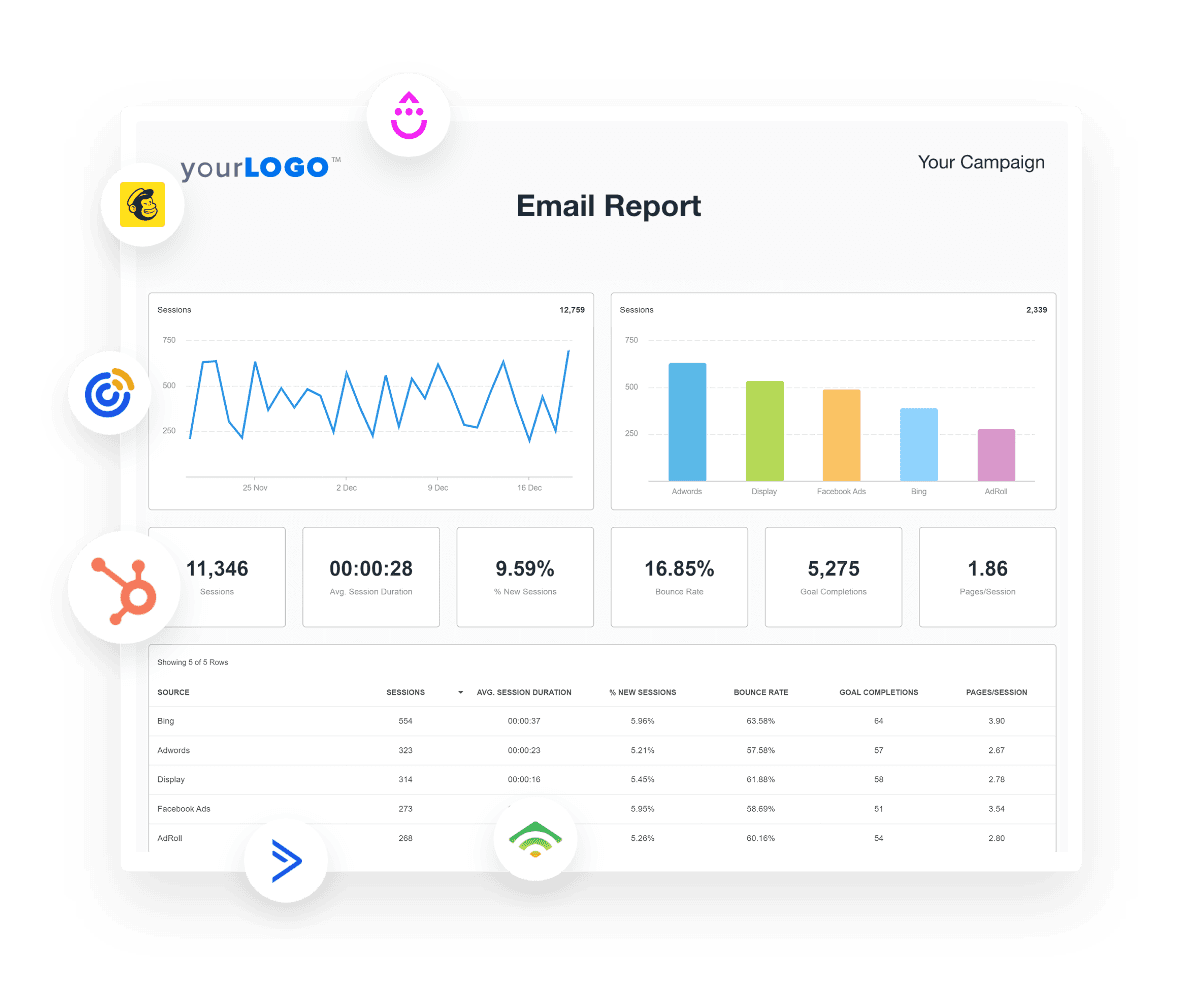
Show clients email marketing ROI by delivering professionally designed, data-driven reports. Try this pre-built email marketing template in AgencyAnalytics–it’s free for 14 days.
Types of Email Marketing Services (and Examples of How To Price Them)
Now that we’ve covered the basics, here’s an overview of the different types of email marketing services and guidance on how to price them.
Keep in mind–it will vary depending on your agency’s level of expertise. However, it’s a good baseline to determine fair, appropriate pricing.
Email Marketing Strategy
A successful email marketing strategy should be the starting point for any client. It typically involves items like deciding on a target audience, conducting a competitor analysis, planning content, and deciding on clear objectives (e.g., boosting brand awareness).
Sometimes, an email marketing strategy may be a standalone deliverable if a client simply needs high-level guidance. Alternatively, it may be included within a bundle package. If you’re offering an email marketing strategy on its own, appropriate pricing models include:
Hourly Rate: Suitable for clients that want flexibility and a clear understanding of time investment. Use this model if the scope is uncertain or if the client may need ongoing adjustments. Also, it could be a preferred option if a client wants a strategy that they’ll execute on their own.
Fixed Project Fee: Ideal for clients who want a comprehensive strategy with clear deliverables. It provides a set cost upfront, which may be appealing for budgeting purposes.
Example: A client with an ecommerce startup wants to adjust an existing strategy. They approach your email marketing agency to develop a high-level plan, which they’ll execute on their own.
Based on this, you’ve decided on an hourly rate that includes:
Market Research: 10 hours @ $100/hour = $1,000
Goal Setting and Content Planning: 15 hours @ $100/hour = $1,500
Total for Strategy and Planning: $2,500
Email Design and Development
This deliverable involves creating visually appealing and effective email templates. Depending on the scope, it may also involve designing custom newsletters for easy replication.
Coding may be needed for more complex campaigns (e.g., responsive email templates). Additionally, consider whether A/B testing is needed to determine the top-performing designs, especially for clients with conversion-oriented goals.
In general, email strategy and design should be charged as a one-off project with a fixed cost. This provides the framework for more streamlined delivery of day-to-day email management. We then typically review strategy and design every 3-6 months with another piece of work.
Ashley Procter, Partner, Pilot
Some appropriate pricing models include:
Per Template Rate: This is ideal if your agency is tasked with developing a few custom templates. It's straightforward and allows clients to pay only for what they need.
Package Deals: Suitable for clients who want multiple templates and comprehensive design services. It’s a strategy to offer better value and encourage larger purchases (e.g., a strategy and design package).
Example: Say you’ve got a retail client who wants to develop fresh templates for recurrent use. It involves graphic design, coding, and testing the most effective design.
A pricing strategy could look like this:
Custom Template Design: 3 templates @ $500 each = $1500
HTML/CSS Coding: Included in the design fee
A/B Testing Setup: $500
Total for Email Design and Development: $2000
Content Creation
Content creation services include creating an email body, devising effective subject lines, and infusing calls to action. They may also include sourcing, creating, and optimizing media (e.g., developing graphics that can be repurposed across SMS marketing efforts).
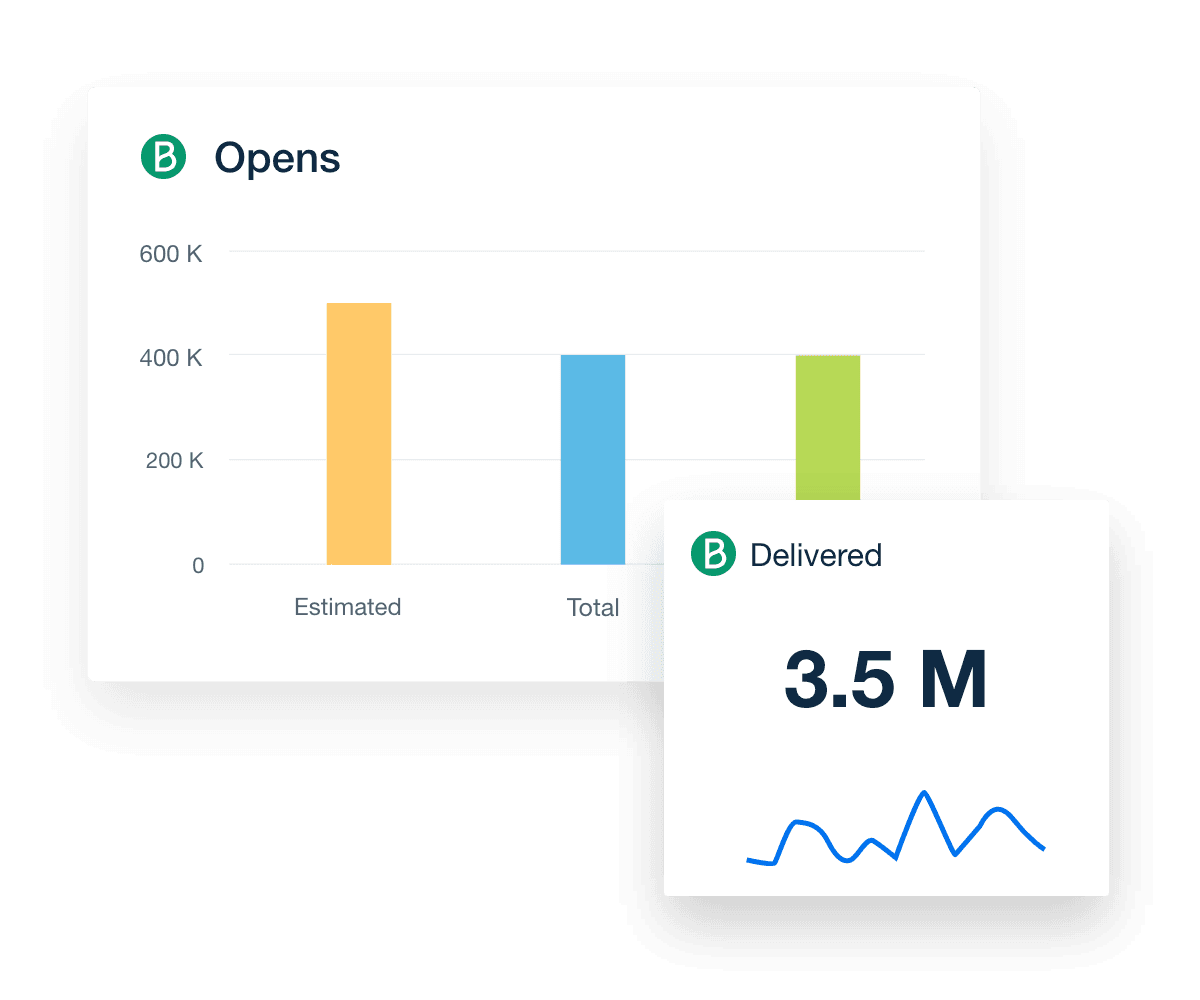
Track key metrics for any email campaign, including delivery rate, open rate, and conversions. Stream data into visual dashboards and reports in AgencyAnalytics–sign up for a free 14-day trial today.
Consider the following pricing models if your agency plans to offer content creation services:
Per-Email Rate: This rate is ideal for clients who need occasional email content. It provides flexibility and is easy to scale up or down.
Monthly Retainer: Consider this strategy for clients with ongoing content needs. It ensures a steady workflow and stable recurring revenue for your agency.
Example: Say you’ve got a client with a mid-sized tech business. They’re ramping up email marketing efforts and want an ongoing package to meet their audience engagement goal. Since they’re signing a long-term contract, there’s an opportunity to include a discount for graphic creation.
Here’s a breakdown of what this may look like:
Copywriting: 4 newsletters per month @ $200 each = $800
Visual Content Creation: Included in the copywriting fee
Monthly Retainer for Content Creation: $800
Campaign Execution
This service includes the actual execution and scheduling of email marketing campaigns. It involves deciding on optimal send times, tracking key metrics (e.g., open rates, click-through rates), and monitoring results. For this service, consider:
A Per Campaign Rate: Best for clients with varying campaign needs (e.g., occasionally sending newsletters). It’s a way to provide flexibility without strict contractual obligations.
Monthly Retainer: Suitable for clients with regular campaign schedules. It ensures continuous support and relationship building.
Example: Imagine you’ve got a client with a travel agency. They’ve already got an in-house designer that creates their campaign graphics. So, they’re depending on your email marketing agency to send campaigns, make tweaks, and track progress.
Their invoice may include the following line items:
Scheduling and Sending: 2 campaigns per month @ $300 each = $600
Monitoring and Reporting: Included in management fee
Campaign Optimization: Included in management fee
Monthly Retainer for Campaign Execution: $600
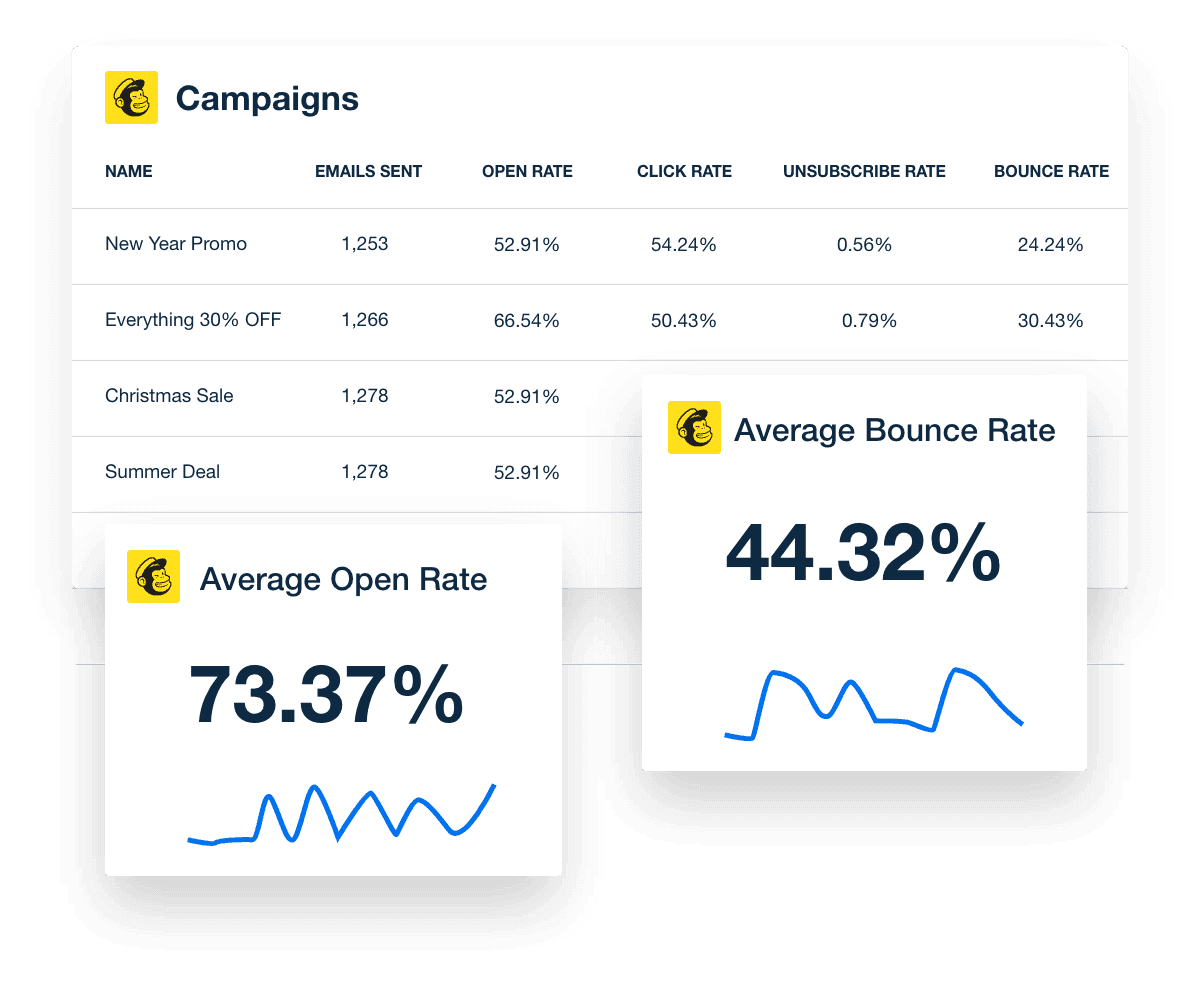
No need to log into your client’s Mailchimp account every time. Invest in a system that automates data retrieval and does the heavy lifting for you–try AgencyAnalytics by signing up for a free 14-day trial.
Email List Management
If your client has an extensive subscriber base, email list management may be a relevant service offering. It involves tasks like list cleaning, creating customer segments, and ensuring compliance with platform regulations.
Having the ability to segment your client’s audience and create buyer personas helps determine what kind of content to create. Segmenting these customers into appropriate email marketing lists helps businesses target these groups more effectively.
Bryan Lozano, Vice President of Operations, Ad-Apt
Email list management is useful to safeguard against high bounce rates or a compromised sender reputation. Appropriate pricing models include:
Per Subscriber Rate: For clients with large email lists, consider offering a list management fee based on the number of subscribers. This is a scalable, straightforward approach that helps clients to budget and understand growing costs.
Monthly Fee: Alternatively, consider a flat monthly fee for clients who need ongoing list management services. It may also be a line item in package-based pricing or even a complementary add-on for a retainer.
Example: Say you’ve got a client in the health and wellness industry. Their email subscriber base is growing exponentially. As a result, they need additional support to create new segments and remove inactive customers each month.
A price breakdown may look like this:
List Segmentation: $0.03 per subscriber for 10,000 subscribers = $300
List Cleaning: $100 per month
Monthly Fee for Email List Management: $400
Automation and Integration Setup
This service involves setting up complex automation, such as workflows for welcome emails, drip campaigns, or retargeting efforts.
It may also include connecting an email marketing tool with a client’s customer relationship management system. That way, there’s a streamlined approach to data management and lead tracking.
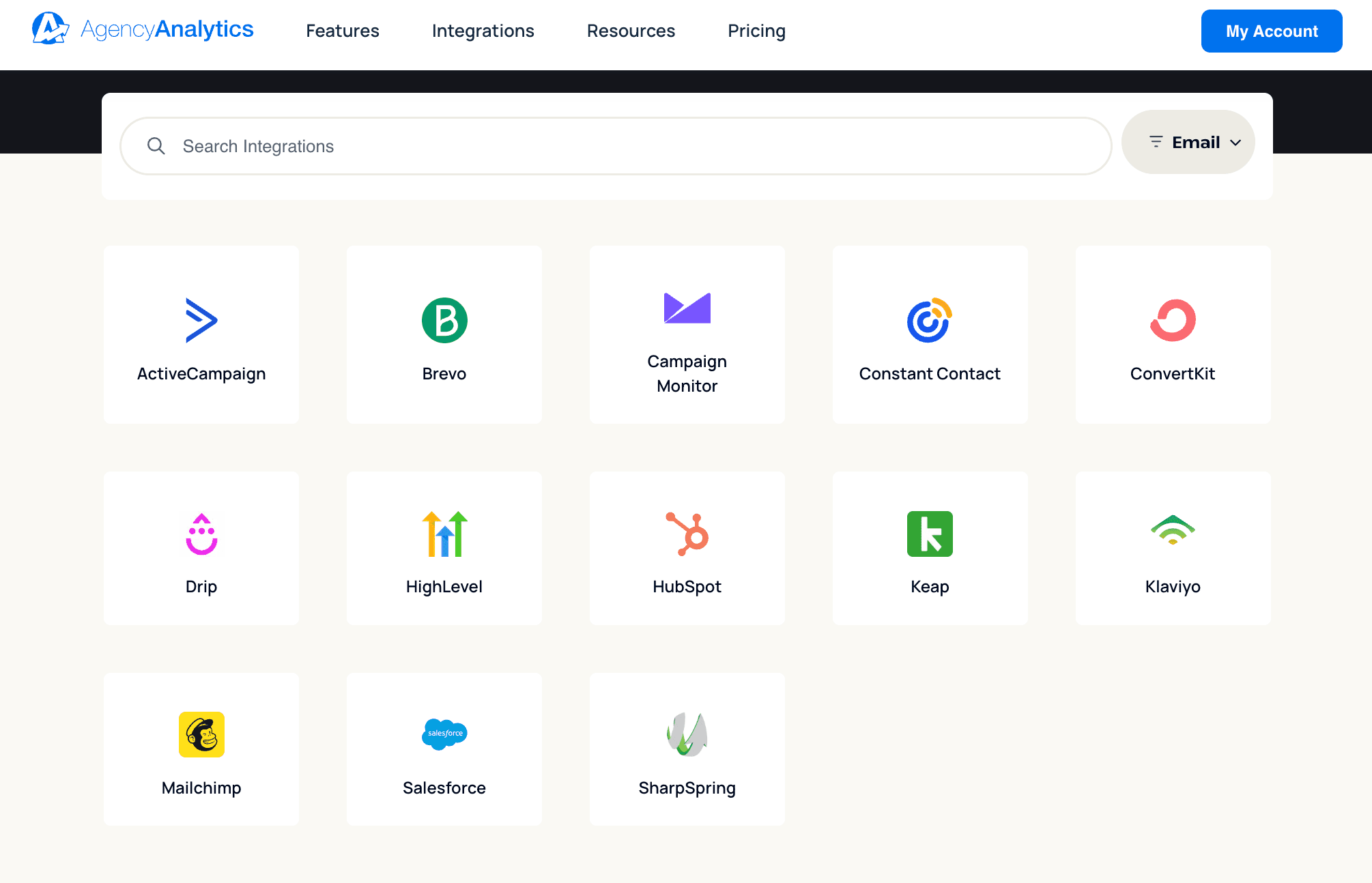
Easily integrate your reporting system with widely used email marketing platforms. Access 80+ integrations in AgencyAnalytics–try it free for 14 days.
If you’re considering this service, here are some appropriate pricing strategies:
Project-Based Fee: Ideal for complex, one-time setups. It provides a clear cost for a defined scope of work.
Retainer Maintenance Fee: Suitable for ongoing support and optimization. It ensures that your client has support for complex workflows and integration setups.
Example: Consider an ecommerce client with an extensive product offering. They’re creating an intricate email campaign to engage potential clients, share product recommendations, and drive sales to meet an annual revenue goal.
Automation Setup: $1,000 for initial setup
CRM Integration: $1,500 for initial setup
API Integration: $3,000 for initial setup
Total for Automation and Integration Setup: $7,000
Have a System to Monitor Email Marketing Results, No Matter the Price
As we’ve covered, many factors influence what agencies charge for email marketing.
Whether it’s your pricing strategy or a specific type of project, it’s important to consider each client request on an individual basis. That said, sending an invoice at the end of the month is only one part of the puzzle. Your agency must have a system in place to monitor results and show clients exactly what they’re paying for.
AgencyAnalytics makes it easy for us to report on specific email campaigns and overall marketing channel performance without having to copy and paste metrics from each platform into a PowerPoint each month. Sharing access to live dashboards with clients allows them to dive deeper into the analytics without needing us to dig up specific metrics on their behalf.
Bryan Lozano, Vice President of Operations, Ad-Apt
With AgencyAnalytics, it’s easy to:
Access data from email marketing platforms, including Drip, SharpSpring, Mailchimp, and 80+ platforms.
Monitor real-time progress, create dynamic goals, and add annotations for context.
Create professional, visually appealing dashboards and reports. Even include metrics across other marketing channels!
Invest in a scalable, data-driven solution that grows with your agency. That way, you’ll be equipped to demonstrate email marketing ROI and keep clients coming back for more. Try AgencyAnalytics today, risk-free–it’s free for 14 days.

Written by
Faryal Khan is a multidisciplinary creative with 10+ years of experience in marketing and communications. Drawing on her background in statistics and psychology, she fuses storytelling with data to craft narratives that both inform and inspire.
Read more posts by Faryal KhanSee how 7,000+ marketing agencies help clients win
Free 14-day trial. No credit card required.




